The GIGABYTE B550I Aorus Pro AX Motherboard Review: All The Small Things
by Gavin Bonshor on December 7, 2020 10:00 AM ESTGaming Performance
For B550 we are running using Windows 10 64-bit with the 1909 update.
World of Tanks enCore
Albeit different to most of the other commonly played MMO or massively multiplayer online games, World of Tanks is set in the mid-20th century and allows players to take control of a range of military based armored vehicles. World of Tanks (WoT) is developed and published by Wargaming who are based in Belarus, with the game’s soundtrack being primarily composed by Belarusian composer Sergey Khmelevsky. The game offers multiple entry points including a free-to-play element as well as allowing players to pay a fee to open up more features. One of the most interesting things about this tank based MMO is that it achieved eSports status when it debuted at the World Cyber Games back in 2012.
World of Tanks enCore is a demo application for a new and unreleased graphics engine penned by the Wargaming development team. Over time the new core engine will implemented into the full game upgrading the games visuals with key elements such as improved water, flora, shadows, lighting as well as other objects such as buildings. The World of Tanks enCore demo app not only offers up insight into the impending game engine changes, but allows users to check system performance to see if the new engine run optimally on their system.
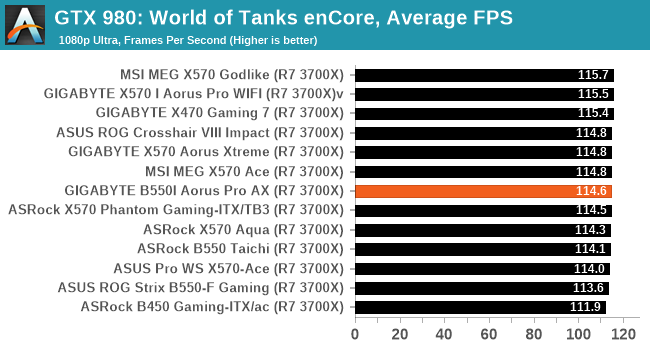
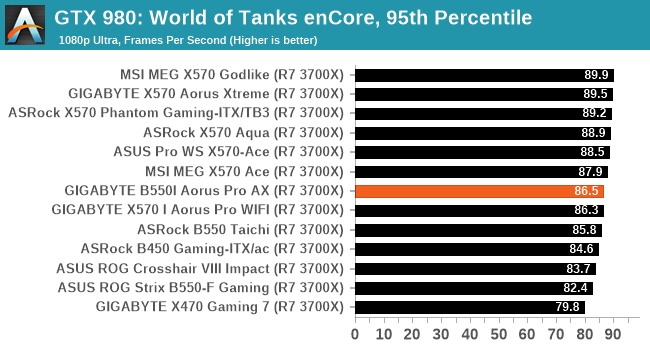
Grand Theft Auto V
The highly anticipated iteration of the Grand Theft Auto franchise hit the shelves on April 14th 2015, with both AMD and NVIDIA in tow to help optimize the title. GTA doesn’t provide graphical presets, but opens up the options to users and extends the boundaries by pushing even the hardest systems to the limit using Rockstar’s Advanced Game Engine under DirectX 11. Whether the user is flying high in the mountains with long draw distances or dealing with assorted trash in the city, when cranked up to maximum it creates stunning visuals but hard work for both the CPU and the GPU.
For our test we have scripted a version of the in-game benchmark. The in-game benchmark consists of five scenarios: four short panning shots with varying lighting and weather effects, and a fifth action sequence that lasts around 90 seconds. We use only the final part of the benchmark, which combines a flight scene in a jet followed by an inner city drive-by through several intersections followed by ramming a tanker that explodes, causing other cars to explode as well. This is a mix of distance rendering followed by a detailed near-rendering action sequence, and the title thankfully spits out frame time data.
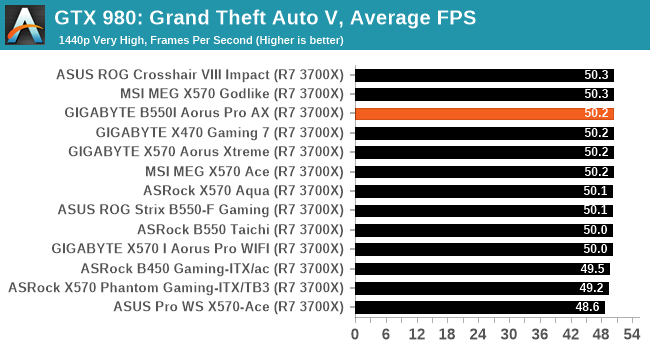
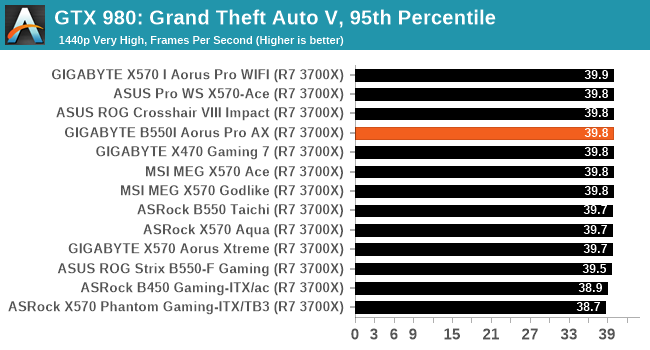
F1 2018
Aside from keeping up-to-date on the Formula One world, F1 2017 added HDR support, which F1 2018 has maintained; otherwise, we should see any newer versions of Codemasters' EGO engine find its way into F1. Graphically demanding in its own right, F1 2018 keeps a useful racing-type graphics workload in our benchmarks.
Aside from keeping up-to-date on the Formula One world, F1 2017 added HDR support, which F1 2018 has maintained. We use the in-game benchmark, set to run on the Montreal track in the wet, driving as Lewis Hamilton from last place on the grid. Data is taken over a one-lap race.
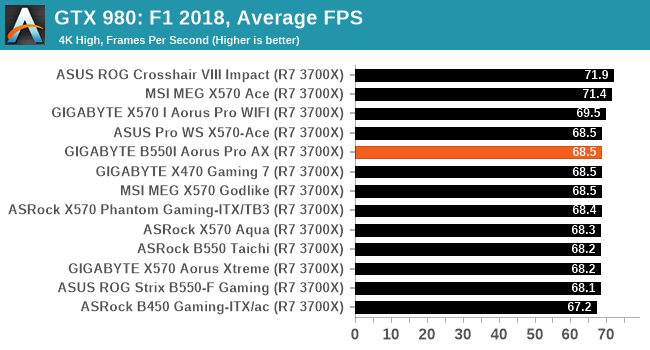
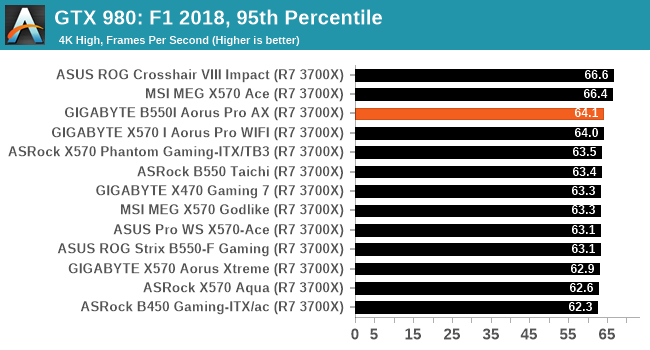


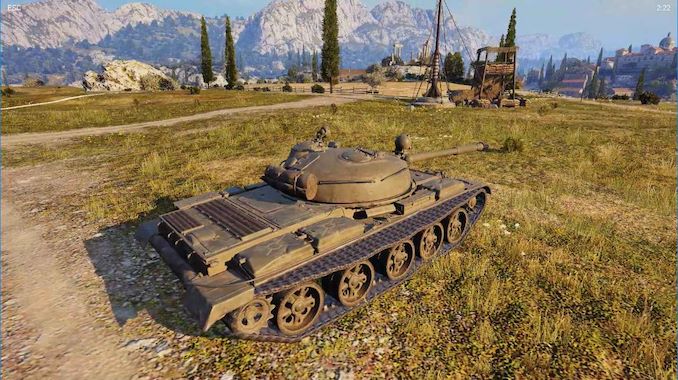










76 Comments
View All Comments
romrunning - Monday, December 7, 2020 - link
Almost all, if not all, of the better B550 ITX boards ($180+) released in June/July of this year have 2.5Gb ports. For onboard 10Gb, you would have to go with some specialized solutions, like the ASRockRack mini-ITX server boards. They have EPYC-based mini-ITX boards and even a X570 board (X570D4I-2T) with 10Gb.Olaf van der Spek - Tuesday, December 8, 2020 - link
Just buy a PCI-E NIC. Oh wait...;)
Dug - Tuesday, December 8, 2020 - link
or wait.. Bifurcationmkarwin - Tuesday, December 15, 2020 - link
Oh wait.. similar approach could almost be used here... If only they added even more higher speeds USB outs (eg. with TB support) one could use them and plug in some USB NIC dongle as a stop gap interim solution... but the amount of 10/5gbps connectors is at a premium here as well ;)mkarwin - Tuesday, December 15, 2020 - link
Especially since 2.5GbE does not force replacement of cabling... and AFAIK costs on the NICs are somewhat similar if not equal. Heck, I wonder why premium ATX boards come with 2 multigig NICs and premium mITX or mATX do not (besides those AsrockRack server'y solutions that skimp on all the other QoL integrations we've come to expect from home/desktop PC parts).lorribot - Monday, December 7, 2020 - link
I would like to see more variation in the features not offered on ITX boards so they could be cheaper. mATX boards are the cheapest you can buy, but also come with a wide range of options, ITX seem to only come fully loaded.First I would delete any Video out capability as most AMD processors have none built in for the majority of users this is pointless. 2.5Gb networking is not required for most people, 2.5GB switches are few and fa between and definitely of no use in the UK for any internet capability and no router in the UK comes with that so you would have pay out for expensive switches, if you really need to move a lot of data. How about no wireless or only wireless? Or dual gigabit.
Task based designs rather than one size fits all.
mkarwin - Tuesday, December 15, 2020 - link
I almost agree... though not entirely.I'd leave one display output, just to appease corporate overlords and PR departments so they could check the box near the "applicable for Ryzen with integrated Radeon solutions"... As to which one to use, that's another question. Perhaps leave only HDMI would appease most users as this is one standard that's proliferated among displays' connectors the widest... Plus, I'd allow sending digital audio from the integrated audio card through the same HDMI connection. But I'd add such a setting on the BIOS level, so as to remove dependency on OS drivers. That'd tick another box on the feature lists... Alternatively, I'd consider using USB-c connected to the CPU - for the port to be used as a DP over USB3-c as it is done on laptops, or as a iGPU output akin to the USB-c port on the new Radeons... Then again if not used in such a manner allow it to be switched to a very fast general purpose USB with connectivity nearly straight to CPU right within the BIOS to again remove any obstacles from driver/OS reworks/compatibilities...
As to networking - I disagree whole-heartedly. I'd say go with dual multigig ports, preferably X550-class based 10GbE. And if 10GbE is too far, go with 2.5 and 5GbE solutions instead. The internet speeds are not the important, most devices are connected to LANs. And here, higher speeds matter much, especially in mITX forms. Why? Cause one could use external storage of NAS variety - it's easier to add tons of disks and copious amounts of space to NASes than to your PC's small mITX cases ;) Plus, you may want to work more using various network appliances, or in enthusiast markets home servers. And for that purpose, high quality high bandwidth NICs are a must. I'd even go one step further, and consider using 2.5/5GbE on all consumer boards and switching to (Q)SFP+ slots to reduce the costs a bit (though I understand that this instead requires more space which is at a premium in smaller builds/MBs). After all the market adoption is driven by the masses, and currently we're having a chicken and egg situation here - most home networks are still at 1GbE speeds cause there aren't many devices most people are using that come with higher speed wired NICs so there's no push towards higher network gear, and since there's no push this not a lucrative enough market for the netowrk appliance manufacturers to start offering faster devices that could support those higher speeds at the prices an average Joe could find enticing. BTW. the enthusiast market as well as pro market have already gone forward and people are already thinking of jumping ship to 10GbE, either in CAT6A/CAT7 or FC forms. Just check the popularity of Mikrotik's 10GbE SFP+ switches... Plus you need to remember that due to smaller consumer base with mostly enthusiasts and pros, companies can easily price those products accordingly and still sell out batches of products - once the speeds become more widespread the rules of competition and market push would enforce price drops for mass-produced offerings. Plus, you'd really need to use 2.5GbE+ wired speeds to keep up with the WiFi6 speeds ;)
And onto the WiFi debacle - I'd still leave the antenna ports, but instead of WiFi/BT module on board, I'd suggest adding M.2 port for those WiFi/BT devices on the back side or on top of M.2/chipsets - that way they'd get the chance to sell another additional product option, one that is tested and used widely in laptops already with success, one used in their NUC-alikes as well, one that's easily replacable or upgradable, and one that could reduce the pricepoint for those not wanting to shell out on sucha feature... That's a fair bit more interesting boxes to tick for the PR people and the "start small go big" mantra...
And speaking of M.2 connectors, I'd really appreciate if more devices actually came with support for 22110 sized ones - even though 2280 has become the defacto standard for M.2 NVMe drives, the 22110 is the one used by the more pro-oriented/server-grade markets due to those usually packing PLP circuitry on board.. That's a tiny QoL feature that could easily differentiate the devices on offer and again allow the PR reps to show how one product stacks better than the competition...
And speaking of server-grade stuff that most MB manufacturers are already doing very well in their server departments, why not dig deeper into those roots as well and start adding BMC in those prosumer solutions? Those in the know would appreciate it, others might find it an extra feature... Sure, Intel has vPro and AMD has joined the game with their Pro series but neither can replace a full BMC solution for remote working/helping...
Now going wireless only solution could sound great on paper but would require a lot work - they'd have to allow WiFi connection management including security/WPS on BIOS level to allow eg. PXE. Furthermore, they'd have to polish the BT issues/stack on BIOS level - so eg. they could allow BT keyboard/mice for system management, so OS agnostic. Furthermore, they might have to instead get in touch with various key/mice manufacturers and license built-in RF transmitters to speak with those devices - its doable and possibly easier than getting BT stack working fully on BIOS/firmware level... Than maybe they'd have to discuss opening to NFC communication. And going back to BT, they'd have to get AptX and similar certs to speak better with wireless audio devices - and that's additional costs many CEOs wouldn't agree to unless presented with a clear ROI numbers... and possibly market adoption of competition's products with similar feature sets. Similarly going the wireless route would necessitate digging into the HDMI over WiFi/WirelessHDMI standards which are not yet adopted widely. I dare say that it's easier to sell the idea of going full 10GbE wired product stacks than finding the wireless HDMI solution markets. Of course having a built-in LTE/5G modem could well play the "going wireless" game in any product stacks but there is another issue going wireless requires - MBs would have to get option to create WiFi networks and act as APs/WiFi routers thus the BIOS would have to get at least a simple WiFi sharing functionality....
Dual gigabit? Nah, that's too restrictive - either think of 4x1GbE or 2x2.5/5GbE or 10GbE. Don't let yourself be rooted in the years old standard that should have already been replaced in all cabled devices.
Now the task based designs could fare great if their implementation was made correctly...
But I'd just consider some copanies thinking of the fact that nowadays smaller boards are not chosen mostly by average users, rather these are power users, enthusiasts, pros... And they need something more for a product to be seen as a premium offering. For example, Gigabyte could have easily gone the Xtreme Waterforce route and create and sell a mITX board with integrated full-board monoblock+pump+res (or monoblock only) that covers CPU+VRM+SoC+M.2 - I bet such a product could easily find new homes among the target consumer group ;) Especially if they priced it right. Heck, Asus could just reach out to EkWB/Bitspower for a cooperation and release boards with blocks out-of-the-factory... I'd say nowadays those smaller monoblocked boards would sell like cupcakes (provided they are priced reasonably) and they could push more people towards custom loops, thus also proliferating monoblocked GPU sells. Or maybe go even one step further and get in touch with both block maker and AIO manufacturers - I think every company would like to consider such cooperation offer to sell truly integrated solutions... for the AIO companies that would have necesiteated only slight adjustments to pump/block/reservoir-combo units to adjust for the full coverage solutions, but you could get far better temps throughout the lifecycle and these would still sell well for the mITX market or even mATX - 240mm/280mm/360mm rads would suffice to cool such full coverage heat sources...
DiHydro - Monday, December 7, 2020 - link
Have you tried to use Smart Fan 5? I found it to be horrible! I have a Noctua CPU cooler and it had the fans spinning at near max, even when the CPU temp was down in the 50°C range.Gigaplex - Tuesday, December 8, 2020 - link
I suspect you're doing it wrong, then. SF5 is working great for me. The fan curve follows the temperatures I set just fine. Each fan port gets its own fan curve, so maybe you're setting the curve on the wrong port?DiHydro - Sunday, December 13, 2020 - link
I did see that it has per fan curves, but the out-of-the-box curves are terribly aggressive. Even in the so called silent mode.